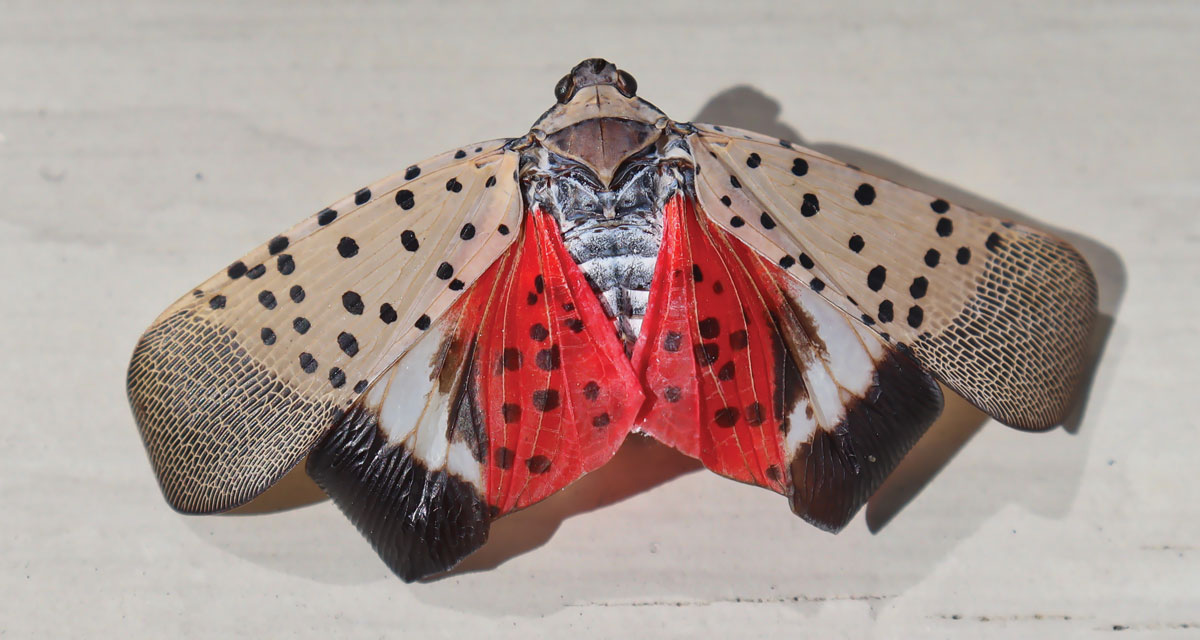It may not be this minute or tomorrow, but something wicked will soon arrive at our doorstep as an infestation—the Spotted Lanternfly, the Asian Longhorned Beetle, or the devilish Fire Ant. Here are some tips on identification and guidance, and how to handle the day when insects fly, hop, or march into our community.
The Spotted Lanternfly
In 2014, the first Spotted Lanternfly arrived in the United States from Korea as a specimen for a conference. The outcome leads nicely to a Jurassic Park quote, “If there is one thing the history of evolution has taught us, is that life will not be contained. Life breaks free; it expands to new territories and crashes through barriers, painfully, maybe even dangerously….”
Despite the valiant efforts to restrict truckers and timber movement, this insect had spread to infest nine states before hopping down to arrive in Hillsville, North Carolina. Just imagine fruit, nut, and hardwood trees or vines, covered in a sticky residue of mold and fungus, attracting other insects! The result is a devastation of our ecosystem.
Appearance
From a distance, most would overlook a textured appearance on the trunk of trees. But in the spring season, if we inspect carefully, the juveniles appear black with flecks of white. By July, adults will possess grey and black forewings, a black polka-dotted red center, and black-tipped rear wings.
Extermination
Although it’s tough to wait for the beneficial bugs, such as spiders and the praying mantis, to accept the challenge of war, the alternative solution is tree banding, a method which wraps a sticky chemical around the tree, killing the infestation. Unfortunately, drenching trees which serve as a pollen and nectar source for pollinators and bees with an insecticide destroys more than the intended target!
The Asian Longhorned Beetle
Already contaminating counties in South Carolina, New York, and Ohio, it’s only a matter of time until the black beetle, featuring white splotches and a long black- and white-banded antenna, arrives. It, too, is difficult to detect, laying eggs underneath the bark and drilling tunnels, the circumference of a pencil, into trees.
Watch for Signs of Stress
As with all living things, signs of stress will become apparent. On trees, defoliation occurs, and leaves will change color and drop, while branches lose moisture and die. The Asian Longhorned Beetle may not be harmful to humans or animals, but it is widely destructive.
A hotline exists, 866-702-9938, for any individual discovering its presence. Photographic evidence is required.
Fire Ants
Eighty out of one-hundred North Carolina counties manifest infestations of fire ants. Originally from South America, these dangerous and aggressive insects have adapted well to the cold, creating innocuous mounds of dirt or sand in sunny locations. Curious humans, wondering why a tall pile of soil has appeared, will often further investigate and prod it with a stick. The outcome might well be an instantaneous outpouring of 20,000 fire ants, seeking to bite and sting any intruder, whether it’s a human or animal.
Allergic Reaction
It may be a joy to walk barefoot in open, dry fields; yet, near a mound may lurk a colony of ants searching for food. They attack, using strong mandibles to inject an alkaloid venom into their victim’s body, while inserting a stinger, leaving two markings. Multiple ant stings can result in symptoms of excessive itching, sweating, nausea, and an allergic reaction leading to enlarged blisters.
Of course, there is a means to eliminate fire ants: leave the extermination to professionals!
Remain Watchful and Observant
Summer is a time of rest and fun. It’s vital to ensure that children and family pets have a safe place to run and play. Take the time to walk around your property with your dog (leashed), using the few minutes to investigate trees and new soil disturbances. With young children, use the moments to openly discuss the signs of a sick tree, the purpose of beneficial insects, and the need to remain vigilant to ecological changes.
*Lisa is an N.C. State Cooperative Extension Master Gardener volunteer and a state-certified beekeeper.























